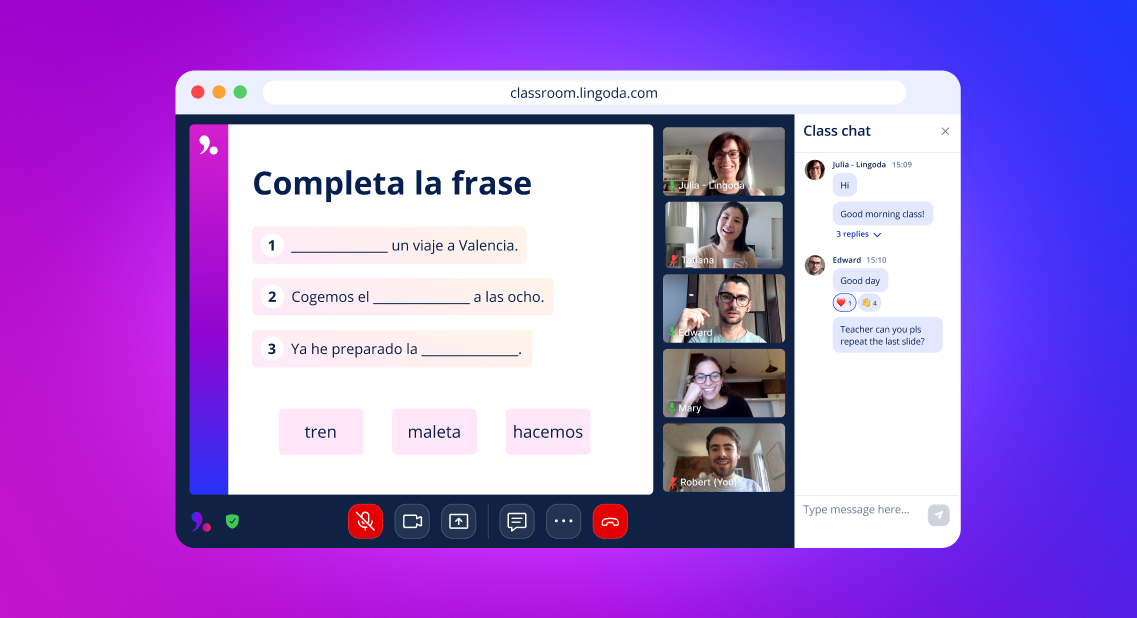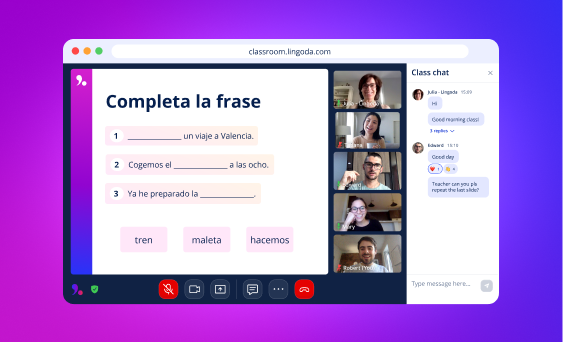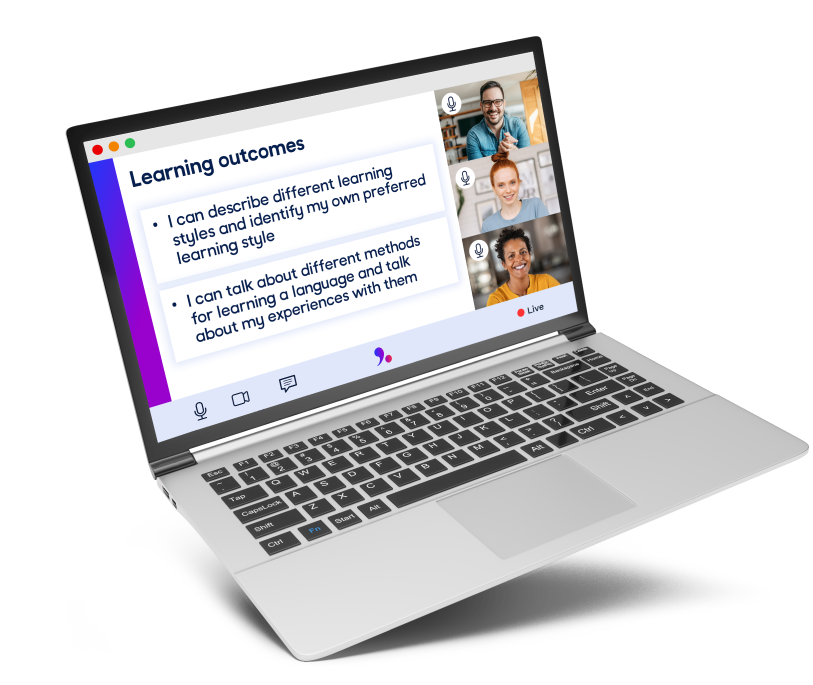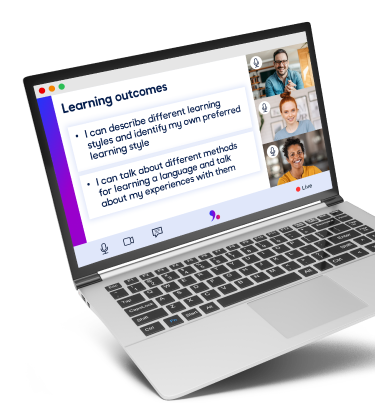


Learn about traditions, festivities, cuisines and other cultural aspects of international Spanish from cities worldwide.



Speak Spanish with confidence. Take our live courses, available for all levels, with professional teachers and transform your skills into life-changing moments



Learn about traditions, festivities, cuisines and other cultural aspects of international Spanish from cities worldwide.



Through a mix of traditional and modern teaching methods, you’ll learn organically the rules and patterns of the language.



Our courses provide you with complete flexibility, whether you’re choosing the time of your class or the subjects you like.
Get inspired by our students' success stories
Hear how our students transformed their first language steps into life-changing moments. Let their stories motivate you to get your own language wins.
From beginner to advanced, our courses are divided into 5 different levels. We teach up to B2 in Spanish.
Don’t know your Spanish level?
Take our placement testWe don’t simply teach Spanish from Spain.
In each lesson, we highlight the linguistic and cultural diversity of a different Spanish-speaking country, focusing on the words, expressions and cultural aspects associated with it. This enriches your learning experience, and builds your confidence and vocabulary so that you can hold conversations with locals in any Spanish-speaking country.




Peek inside a class, discover how to book a lesson and what extra studying opportunities there are for you.

Recommended by other students
Frequently asked questions
Our limited-time offer on Lingoda Flex monthly plans is for new students starting their language journey. This offer applies to Flex subscription purchases made between 2 – 8 July 2025 (until 10 AM CET).Discounts are tiered, and our smallest plan is excluded. Based on your subscription plan, you can get up to 30% off. The discount is applied immediately and is valid only for the first month’s payment. The offer cannot be combined with any other discounts or promotions and is only valid for new students.
As a Lingoda student, you can download the class materials for free and use them at any time. After your class, you will also find a quiz to help you refresh and practice your new skills. There are also downloadable exercises available. All materials are uniquely created by Lingoda experts to align with CEFR standards. If you want to learn more about CEFR, read more here.
After scheduling a Spanish class on our platform, you will be able to join the class with 2-4 fellow students from around the world. The teacher will introduce themselves and begin teaching the lesson using learning materials that you can download at the end of class. You will be able to interact with the teacher and other students, but there is no pressure to do so. Towards the end of class, the teacher will recap the lesson and ensure everybody has understood the lesson.
Both group and private classes are very effective with Lingoda, but it depends on your personal preferences what you’d like to do.
No, we are not a language learning app. We are an online language school. And like any school, we offer live classes with certified, native-speaking teachers. At Lingoda, we believe that nothing can replace live interaction and customised feedback from a real person.
Preparing to learn Spanish online with us is simple. You need three things: a stable internet connection, a computer and the free video conferencing tool Zoom.
It depends. As is the case when learning any new skill, your progress depends on your efforts. If you would like to learn Spanish online quickly, then we suggest that you make language learning a consistent habit. Also focus and participate in class and complete the downloadable materials at the end of each class for best results. It also depends on which of Lingoda’s online Spanish language courses you choose, as some of our plans are more intensive than others.
All of our Spanish teachers are native speakers, no exceptions. They are also highly-qualified. We are strict with hiring only teachers that have years of experience and can provide the highest quality teaching. Our teachers are also trained with the Lingoda method and standard, so you can learn Spanish online smoothly.
Learning Spanish online is not enough? Then visit our French page and learn French online!

Here at Lingoda, we firmly believe that the best way to learn Spanish is in a supportive learning environment, using a communication-based approach taught by high-quality teachers. This method allows you to improve your competency quickly and ensures that any mistakes or inaccuracies are swiftly corrected.
Our online Spanish course combines traditional and modern teaching methods and is conducted entirely online. We strictly hire fully qualified, experienced, native-level teachers. All you need to learn is a computer and a stable internet connection. We offer flexible options to suit your schedule, and you’ll have plenty of opportunities to interact with your teacher and the other students in your class.
Our approach not only helps you develop an understanding of Spanish but also gives you the confidence to use it in real-life situations. Crucially, our Spanish classes will help you improve your speaking, listening, reading, and writing skills.
Like any language, Spanish has its share of complexities, especially when it comes to grammar and pronunciation. However, it’s generally regarded as one of the easier languages for English speakers to pick up. With the right amount of effort and structured lessons, you can progress your Spanish skills quite quickly.
It’s worth noting that Spanish is the world’s second-most spoken native language and the fourth-most spoken language globally. Yet, there are significant variations. For instance, there are some notable differences between the Spanish spoken in Spain and the Spanish spoken in countries like Argentina, Bolivia and Mexico.
At Lingoda, we’re passionate about the international nature of the Spanish language. Our lessons embrace the linguistic differences that exist across different regions. With us, you won’t just learn Spanish from Spain or Spanish from Mexico. Instead, you’ll learn to understand the differences in grammar, pronunciation and slang.
When you learn Spanish online with Lingoda, you can choose from the Flex course or Sprint course.
As the name suggests, our Flex Spanish course emphasizes flexible learning schedules, allowing you to adjust the intensity of your learning every four weeks. You’ll learn at your own pace in small groups of up to five students or through one-to-one private classes with a fully qualified, native-level teacher.
On the other hand, our Sprint course is all about fast progress in a two-month challenge. You can choose between 15 or 30 classes per month, and learning will take place in classes of up to five students. If you follow all the rules and complete the Sprint course, you’ll receive 50% of your money back or even more if you opt for class credits.
Learning is supplemented with free downloadable class materials and refresher quizzes.
When you take an online Spanish course, you need to know that you’re learning at the appropriate level for your current ability. Our Spanish courses cover the following learning levels:
Whatever your current ability level, you’ll be able to dive right in and learn Spanish with Lingoda. By the time you complete our Level B2 course, you’ll feel comfortable having technical discussions and reading about abstract ideas and topics, and you’ll have developed a functional level of fluency.
If you’re completely new to learning Spanish, with no previous experience, you can safely jump into Spanish classes at level A1: Absolute Beginner. However, if you’ve previously attempted to learn Spanish or are moving from another online Spanish course, you’ll need to know your current level to pick up from where you left off.
If you already know your current level of Spanish, you’re ready to get started, but what if you’re unsure of your current language level? After all, you don’t want to join a course, only to find it’s covering topics you already know.
Fortunately, we offer a simple Spanish language placement test, which can give you an indication of your current level. The test is easy to understand and takes around five minutes. Once you finish, we’ll email you the results. This way, you can make a more informed decision about where to begin as you start to learn Spanish online with Lingoda.